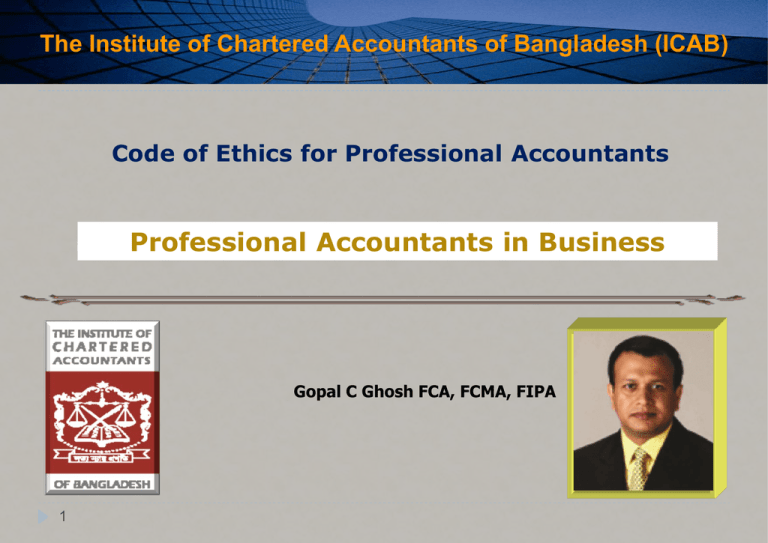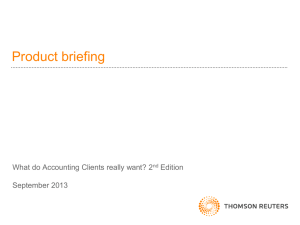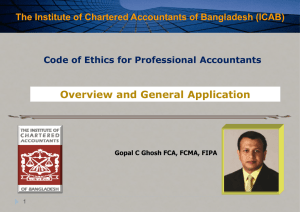COE Professional Accountants in Business
advertisement

The Institute of Chartered Accountants of Bangladesh (ICAB) Code of Ethics for Professional Accountants Professional Accountants in Business Gopal C Ghosh FCA, FCMA, FIPA 1 Parts of Code This Code contains three parts: Part-A General Application of the Code Part-B Professional Accountants in Public Practice Part-C Professional Accountants in Business 2 Threats Threats fall into one or more of the following categories: Self-interest Self-review Advocacy Familiarity Intimidation 3 Code of Ethics Part-C : Professional Accountants in Business This Part of the Code describes how the conceptual framework contained in Part A applies in certain situations to professional accountants in business. 4 Code of Ethics Responsibilities to Stakeholders At Large Investors, creditors, employers and governments and the public at large may rely on the work of professional accountants in business. Professional accountants in business may be solely or jointly responsible for the preparation and reporting of financial and other information. They may also be responsible for providing effective financial management and competent advice on a variety of business-related matters. 5 Code of Ethics Types of Engagements A professional accountant in business may be: • a salaried employee, • a partner, • a director (whether executive or non-executive), • an owner manager, a volunteer or • another working for employing organization. The legal form of the relationship, if any, has no bearing on the ethical responsibilities incumbent on the professional accountant in business. 6 Code of Ethics Responsibility for Ethical Culture • May hold a senior position within an organization. • The more senior the position, the greater will be the ability and opportunity to influence events, practices and attitudes. • Expected to encourage an ethics-based culture in an employing organization that emphasizes the importance that senior management places on ethical behavior. 7 Code of Ethics Impact of Other Engagements A professional accountant in business shall not knowingly engage in any business, occupation, or activity that impairs or might impair integrity, objectivity or the good reputation of the profession and as a result would be incompatible with the fundamental principles. 8 Threats Compliance with the fundamental principles may potentially be threatened by a broad range of circumstances and relationships. Threats fall into one or more of the following categories: Self-interest Self-review Advocacy Familiarity Intimidation 9 Threats Self-interest threat – the threat that a financial or other interest will inappropriately influence the professional accountant’s judgment or behavior; 10 Threats Self-interest threat - Examples • Holding a financial interest in, or receiving a loan or guarantee from the employing organization. • Participating in incentive compensation arrangements offered by the employing organization. • Inappropriate personal use of corporate assets. • Concern over employment security. • Commercial pressure from outside the employing organization. 11 Threats Self-review threat – the threat that a professional accountant will not appropriately evaluate the results of a previous judgment made, or activity or service performed by the professional accountant, on which the accountant will rely when forming a judgment. 12 Threats Self-review threat – Example Determining the appropriate accounting treatment for a business combination after performing the feasibility study that supported the acquisition decision. 13 Threats Advocacy threat – the threat that a professional accountant will promote a client’s or employer’s position to the point that the professional accountant’s objectivity is compromised; 14 Threats Advocacy threat – Example When furthering the legitimate goals and objectives of their employing organizations, professional accountants in business may promote the organization’s position, provided any statements made are neither false nor misleading. 15 Threats Familiarity threat ─ the threat that due to a long or close relationship with a client or employer, a professional accountant will be too sympathetic to their interests or too accepting of their work; and 16 Threats Familiarity threat – Example • When an immediate or close family member employed by the entity makes decisions that affect the entity’s financial reporting. • Long association with business contacts influencing business decisions. • Accepting a gift or preferential treatment, unless the value is trivial and inconsequential. 17 Threats Intimidation threat – the threat that a professional accountant will be deterred from acting objectively because of actual or perceived pressures, including attempts to exercise undue influence. 18 Threats Intimidation threat – Example • Threat of dismissal or replacement of the professional accountant in business or a close or immediate family member over a disagreement about the application of an accounting principle. • A dominant personality attempting to influence awarding of contracts or the application of an accounting principle. 19 Safeguards Safeguards are measures that may eliminate threats or reduce them to an acceptable level. They fall into two broad categories: (a) Safeguards created by the profession, legislation or regulation; and (b) Safeguards in the work environment. 20 Safeguards Safeguards created by the profession, legislation or regulation include: • Educational, training and experience requirements for entry into the profession. • Continuing professional development requirements. • Corporate governance regulations. • Professional standards. • Professional or regulatory monitoring and disciplinary procedures. • External review by a legally empowered third party. 21 Safeguards Certain safeguards may increase the likelihood of identifying or deterring unethical behavior. Such safeguards, which may be created by the accounting profession, legislation, regulation, or an employing organization, include: • Effective, well-publicized complaint systems operated by the employing organization, the profession or a regulator, which enable colleagues, employers and members of the public to draw attention to unprofessional or unethical behavior. • An explicitly stated duty to report breaches of ethical requirements. 22 Safeguards Safeguards in the work environment - Example: • The employing organization’s ethics and conduct programs. • Strong internal controls. • Appropriate disciplinary processes. • Leadership that stresses the importance of ethical behavior and the expectation that employees will act in an ethical manner. 23 Safeguards Safeguards in the work environment - Example: • Policies and procedures to implement and monitor the quality of employee performance. • Policies and procedures to empower and encourage employees to communicate to senior levels within the employing organization any ethical issues that concern them without fear of retribution. • Consultation with another appropriate professional accountant. 24 Safeguards Unusual circumstances Where a professional accountant in business believes that unethical behavior or actions by others will continue to occur within the employing organization, the professional accountant in business may consider obtaining legal advice. Where all available safeguards have been exhausted and it is not possible to reduce the threat to an acceptable level, a professional accountant in business may conclude that it is appropriate to resign from the employing organization. 25 Conflicts of Interest A conflict of interest creates a threat to objectivity and may create threats to the other fundamental principles. Such threats may be created when: • The professional accountant undertakes a professional activity related to a particular matter for two or more parties whose interests with respect to that matter are in conflict; or • The interests of the professional accountant with respect to a particular matter and the interests of a party for whom the professional accountant undertakes a professional activity related to that matter are in conflict. 26 Conflicts of Interest - Example • Preparing financial information for certain members of management of the entity employing the professional accountant who are seeking to undertake a management buy-out. • Being responsible for selecting a vendor for the accountant’s employing organization when an immediate family member of the professional accountant could benefit financially from the transaction. • Serving in a governance capacity in an employing organization that is approving certain investments for the company where one of those specific investments will increase the value of the personal investment portfolio of the professional accountant or an immediate family member. 27 Conflicts of Interest - Identification In identifying whether a conflict of interest exists or may be created, a professional accountant in business shall take reasonable steps to determine: • The nature of the relevant interests and relationships between the parties involved; and • The nature of the activity and its implication for relevant parties. 28 Conflicts of Interest - Evaluation If a conflict of interest is identified, the professional accountant in business shall evaluate: • The significance of relevant interests or relationships; and • The significance of the threats created by undertaking the professional activity or activities. 29 Conflicts of Interest - Safeguards Depending on the circumstances, application of one or more of the following safeguards may be appropriate: • Restructuring or segregating certain responsibilities. • Obtaining appropriate oversight, for example, acting under supervision of executive or non-executive director. • Withdrawing from the decision-making process related to the matter giving rise to the conflict of interest. • Consulting with third parties, such as a professional body, legal counsel or another professional accountant. 30 Conflicts of Interest - Disclosure Disclosure as a Safeguard: • It is generally necessary to disclose the nature of the conflict to the relevant parties, including to the appropriate levels within the employing organization and, when safeguards are required to reduce the threat to an acceptable level, to obtain their consent. • In certain circumstances, consent may be implied by a party’s conduct where the professional accountant has sufficient evidence to conclude that parties know the circumstances. 31 Preparation and Reporting of Information • A professional accountant in business shall prepare or present ALL information fairly, honestly and in accordance with relevant professional standards. • A professional accountant in business who has responsibility for the preparation or approval of the general purpose financial statements of an employing organization shall be satisfied that those financial statements are presented in accordance with the applicable financial reporting standards. 32 Preparation and Reporting of Information A professional accountant in business shall take reasonable steps to maintain information for which he/she is responsible in a manner that: (a) Describes clearly the true nature of business transactions, assets, or liabilities; (b) Classifies and records information in a timely and proper manner; and (c) Represents the facts accurately and completely in all material respects. 33 Acting with Sufficient Expertise The fundamental principle of professional competence and due care requires that a professional accountant in business only undertake significant tasks for which he/she has sufficient specific training or experience. A professional accountant in business shall not intentionally mislead an employer as to the level of expertise or experience possessed, nor shall a professional accountant in business fail to seek appropriate expert advice and assistance when required. 34 Acting with Sufficient Expertise Circumstances that create a threat: • Insufficient time for properly performing or completing the relevant duties. • Incomplete, restricted or otherwise inadequate information for performing the duties properly. • Insufficient experience, training and/or education. • Inadequate resources for the proper performance of the duties. 35 Acting with Sufficient Expertise Examples of safeguards include: • Obtaining additional advice or training. • Ensuring that there is adequate time available for performing the relevant duties. • Obtaining assistance from someone with the necessary expertise. • Consulting, where appropriate, with: o Superiors within the employing organization; o Independent experts; or o A relevant professional body. 36 Self-interest Threats Financial Interests, Compensation, and Incentives Linked to Financial Reporting and Decision Making For example, self-interest threats to objectivity or confidentiality may be created through the existence of the motive and opportunity to manipulate pricesensitive information in order to gain financially. 37 Self-interest Threats Professional accountants in business may have financial interests arising from compensation or incentive arrangements, or may know of financial interests of immediate or close family members, that, in certain circumstances, may create threats to compliance with the fundamental principles. For example, self-interest threats to objectivity or confidentiality may be created through the existence of the motive and opportunity to manipulate pricesensitive information in order to gain financially. 38 Self-interest Threats Self-interest threats arising from compensation or incentive arrangements may be further compounded by pressure from superiors or peers in the employing organization who participate in the same arrangements. For example, such arrangements often entitle participants to be awarded shares in the employing organization at little or no cost to the employee provided certain performance criteria are met. In some cases, the value of the shares awarded may be significantly greater than the base salary. 39 Self-interest Threats - Safeguards Examples of safeguards include: • Policies and procedures for a committee independent of management to determine the level or form of remuneration of senior management. • Disclosure of all relevant interests, and of any plans to exercise entitlements or trade in relevant shares, to those charged with the governance of the employing organization, in accordance with any internal policies. • Consultation with superiors within the employing organization. • Consultation with those charged with the governance of the employing organization or relevant professional bodies. • Internal and external audit procedures. • Up-to-date education on ethical issues and on the legal restrictions and other regulations around potential insider trading. 40 Learning For Professional Accountants in Business a. Threats to Fundamental Principles and Safeguards. b. Conflict of Interest and resolution process 41 Questions 42 Thank You http://www.eruditeape.com/mcq-quizzes/ias-10events-after-the-reporting-period-quiz/ 43









